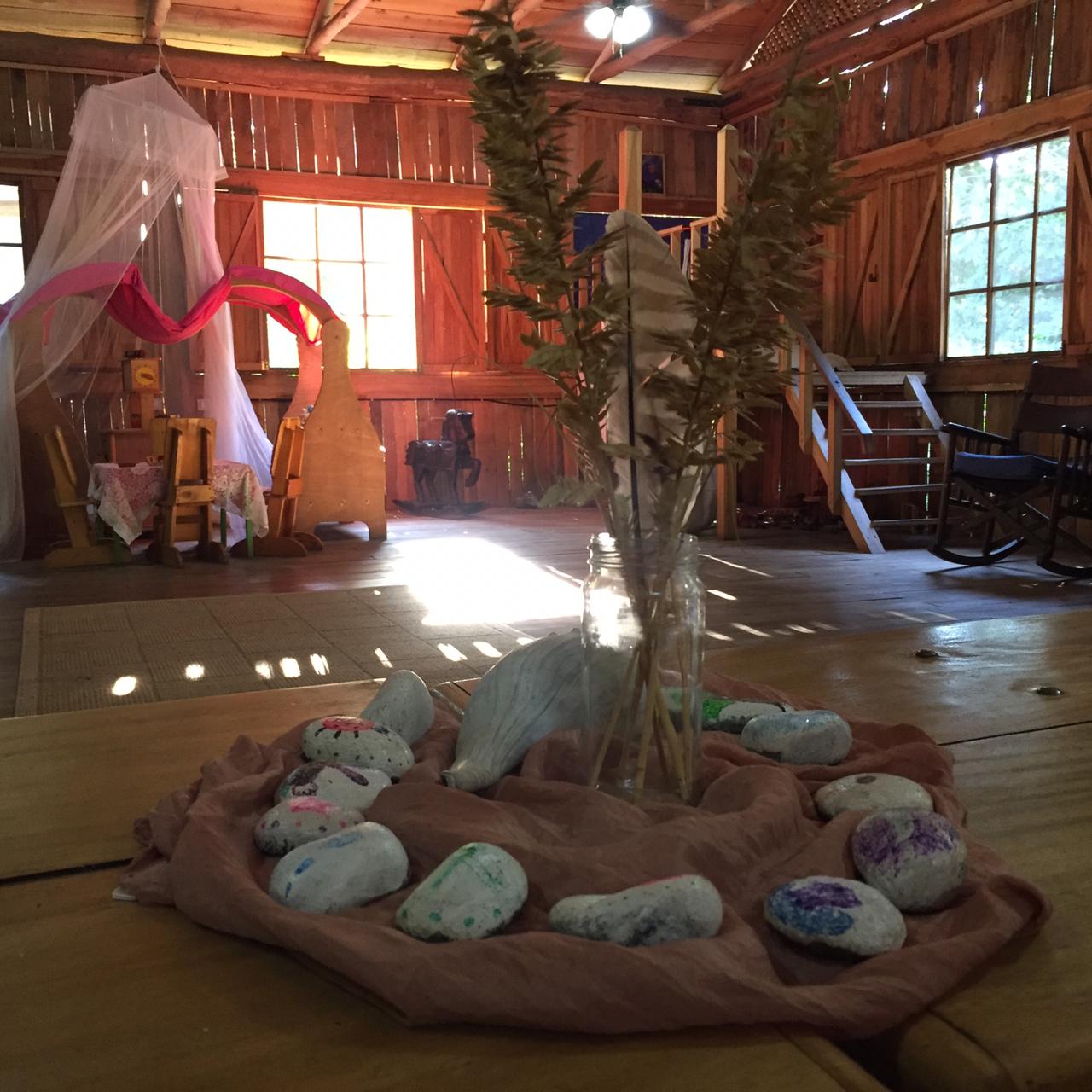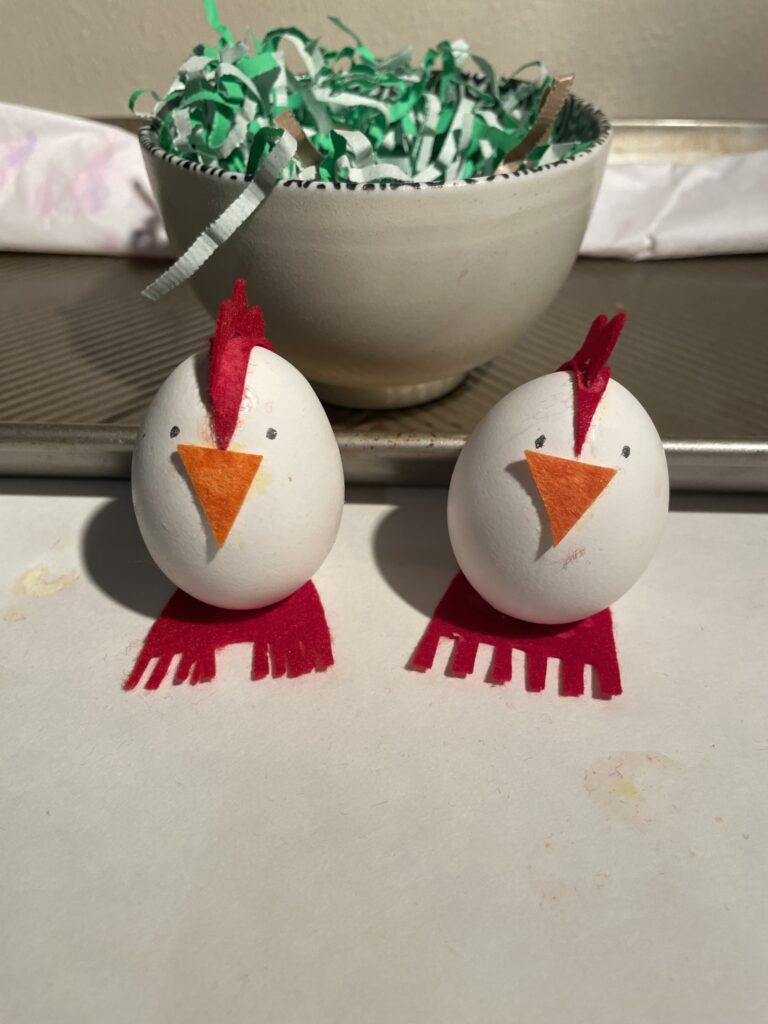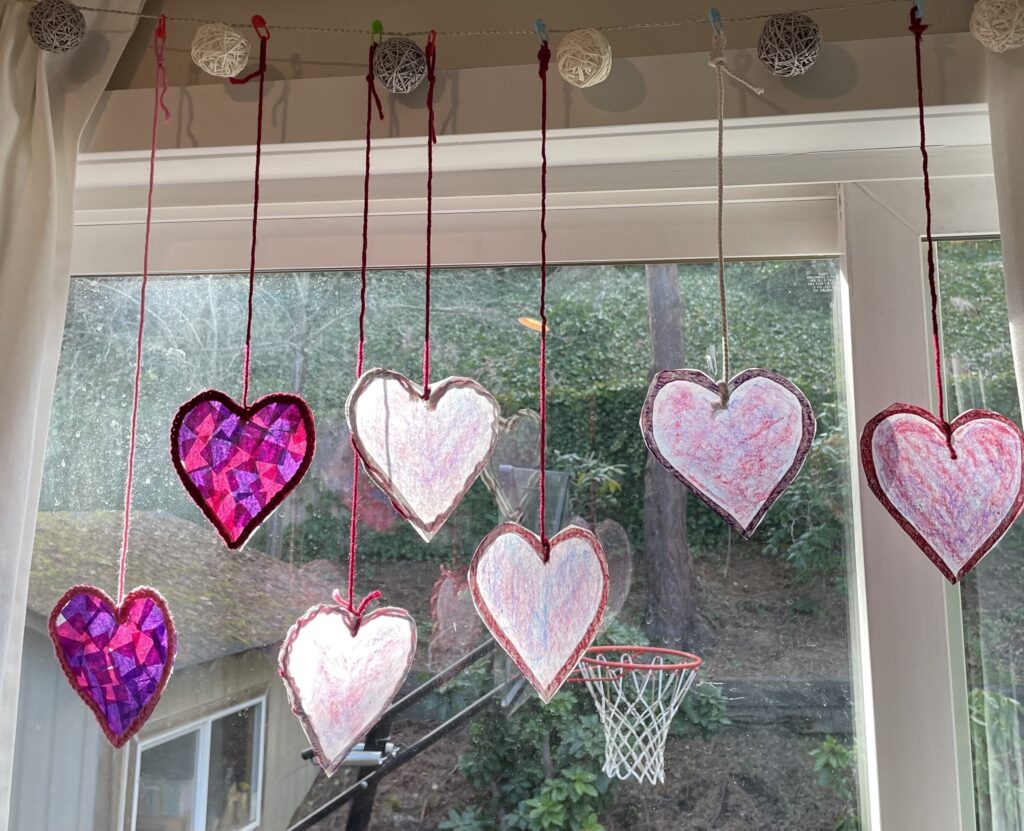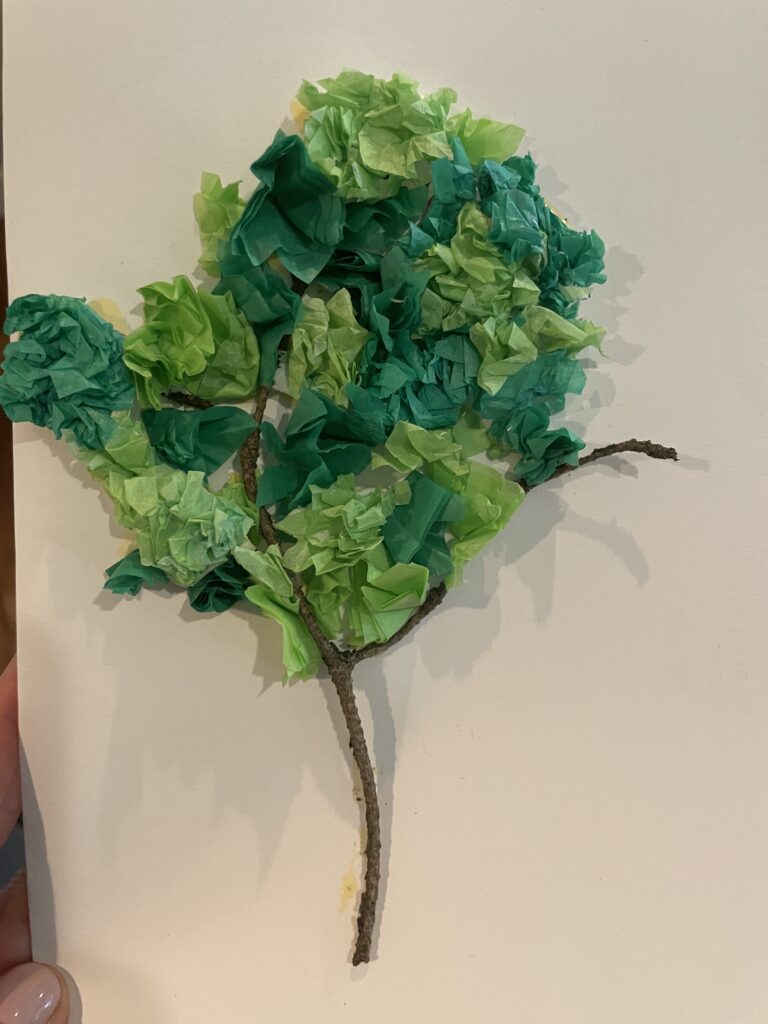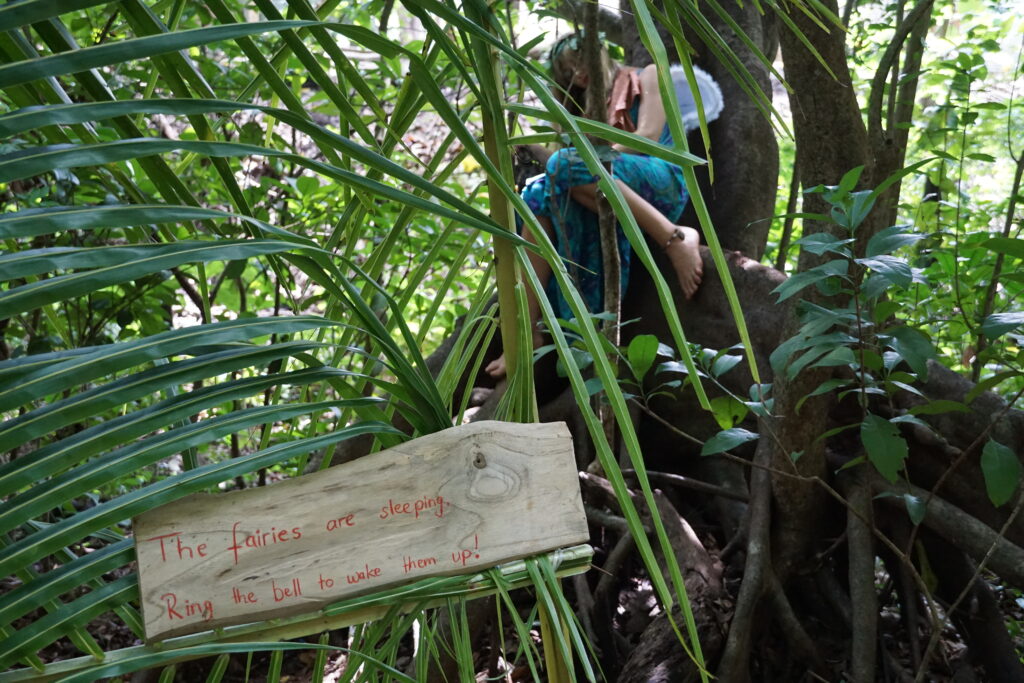This craft is very simple and fun to make with children. For the young child it is advised to have the help of an adult. Use hallowed-out eggshells and a few craft supplies to make a flock of chicks. You can begin with white eggs or dye them yellow or orange or even brown. It is sure a great way to make chickens and decorate a nest.
Category: Early Childhood
God’s Eyes
God’s Eyes are a classic craft that is soothing for children. Young children enjoy the satisfying feeling of turning the branches making colorful patterns. It is a great hobby to do along with finger knitting, especially for the kindergarten and lower grade classes.
Valentine’s Day Celebration
Valentine’s day origin
Valentine’s day celebration is an occasion in many countries. Where did the celebration initiate? How did it become popular? Where does the name come from?
There are different theories based on stories from many years ago. One of the legends took place long before Valentine became the patron saint of lovers or love. This legend narrates the events from a festival that was held in ancient Rome during the month of February, in honor of the great god Pan. The festival was called Lupercalia. One of the customs was to draw the names of young men and women in the form of a lottery to choose token boyfriends.
Another theory, with a closer relation to Valentine’s name, took place during the 3rd century. The Bishop of Rome, Valentine, was martyred on the eve of the Lupercalia festival. He was a man known for his kindness and chastity and eventually the festival acquired its name after him. It may have been the poet Geoffrey Chaucer who initiated the connection between Valentine’s day and romance. Around the 1370s-1380s Chaucer wrote a poem named “Parliament of Fowls”. The poem had this quote: “For this was on Saint Valentine’s Day, when every bird comes there to choose his mate.” In the 1300s writers celebrated romance between knights and noble ladies, who could not marry or were promised to other men.
The idea of a day to celebrate romance and love became popular around the 1400s. In February 14th, Valentine’s day started to be celebrated. I like the story of the Valentine’s priest and its connection to the celebration, in particular for the symbol of love and gratitude.
Saint Valentine story
The Saint Valentine story narrates:
“Saint Valentine was a priest who practiced in Rome around the third century. At that time, Emperor Claudius II ruled, who decided to prohibit the celebration of marriages for young people, because in his opinion singles without families were better soldiers, since they had fewer ties.
The priest considered the decree unfair and challenged the emperor. He secretly celebrated marriages for young lovers. Hence it has become popular that Valentine is the patron saint of lovers. Emperor Claudius found out and as Valentine enjoyed great prestige in Rome, the emperor called him to the Palace. Valentine took advantage of that occasion to promote Christianity.
Although at first Claudius II showed interest, the army and the Governor of Rome, called Calpurnio, persuaded him to get it out they way.
Emperor Claudius then gave the order to imprison Valentine. So, the officer Asterius, in charge of imprisoning him, wanted to ridicule and test Valentin. He challenged him to restore sight to his daughter, named Julia, who was born blind. Valentine accepted and in the name of the Lord, he restored her sight.
This fact convulsed Asterius and his family, who converted to Christianity. In any case, Valentine remained in prison. Eventually the weak Emperor Claudius ordered to martyr and execute Valentine on February 14, 270. On the day of his execution, he left the girl a note signed, “Your Valentine.” The young Julia, grateful to the saint, planted an almond tree with pink flowers next to his grave. Hence, the almond tree is a symbol of lasting love and friendship.”
~ Saint Valentine is the patron of couples, happy marriages, beekeepers and love.

Symbols of the celebration
The element of gratitude and the theme of love remain. Flowers, red heart shapes, lace, and birds are symbols of this celebration. For children, it is the element of love and friendship in a card that keeps the enjoyment of the day. February 14 is often a Valentine’s day celebration in many primary grade classrooms. In honor of the celebration of love and friendship, children make their own cards. Often they make gifts for friends and families.
Crafts or gifts to make
I have made crafts with different class groups ranging from: felted hearts, sewing heart shaped pillows, to making cards, sun catchers, heart mobiles and more. During Valentine’s day , baking together to bring a delicious treat home was a loved activity. Our class would plan a special class excursion after school to the middle of town on Valentine’s day. The children would decorate a big tree in the center of town. Decorations were from all kinds of crafts which the class and school had made. Families would join and we would all spend some time at the near beach. Some great memories!

In any way you prefer to have a Valentine’s day celebration with your loved ones, I hope it is a fun time. To help you create a nice craft or treat with your class or at home, check the following posts: craft “Sun catcher hearts” and recipe “Heart shaped sugar cookies with natural frosting”, both for all ages. Happy Valentine’s Day!
Heart Shaped Sugar Cookies Recipe
The Heart shaped sugar cookies recipe is a wonderful way to make a nice treat for Valentine’s day. You may make them just as they are for a less sugar option (with white or brown sugar). You may also glaze them with the natural color frosting suggested. Sweets and chocolates are a classic during this time in spite of our healthy habits.
If you choose to make a delicious dessert with your little ones, this heart shaped sugar cookie recipe does not fail. The frosting is made with natural ingredients. Dried strawberries make the heart shaped sugar cookie frosting color. Check the provided link to dry your own fresh strawberries.
For the frosting add butter, milk and powdered sugar. The natural color of the strawberries give a fucsia tint depending on the amount of strawberry powder. Also it could make a lighter pink adding more frosting. Enjoy the sweetness and delicious flavor of these heart shaped sugar cookies with the hint of strawberry taste. Below both recipes for the cookies and frosting.
Check out also our Valentine’s craft suggestion, suncatcher hearts! Contact us with comments or suggestions and please subscribe for additional content. You may also want to check and register to any of our memberships for continuos support.

Suncatcher Hearts Craft
This Suncatcher Hearts craft is a simple and beautiful art appropriate for all ages. You may adjust the level of difficulty according to age and dexterity per the suggestions. You may review other suggestions for crafts or recipes in our other recent posts. Alternatively you may subscribe to receive our posts. If you need continuos material and ideas for your class, please register to one of our curriculum packages for stories, blocks, circles and more. Contact us with any questions.

Crafting With Younger Children
Values
Gratitude is a feeling we cultivate in children since they start communicating. Prompting them to say the magic word or to be polite in their interaction with us and others are a few ways to encourage thankfulness. During a special time or a holiday, cards are a wonderful way to express our gratitude, love or caring. As we start the new year, making crafts with our children or the children we teach is fun and enhances values that will remain with them. Empathy and showing our feelings for others are part of these values that are cultivated when we make a birthday, holiday card or write a thank you note.
Fine Motor Skills
Besides being a fun activity and a wonderful way to foster good values, a craft with younger children stimulates their fine motor skills and artistic abilities. In Waldorf schools, this premise is observed in all daily activities: Academic lessons with crayon and pencil drawings, painting, crafts, foreign language lessons, circus arts, and more. Below are a couple of crafts that will bring joy to your classroom or family free time. I recommend this craft for all ages, but variations for pre-k children are suggested. I hope this brightens your crafting time.
Halloween and All Saints’ Day
Halloween origin
The origin of the Halloween celebration goes back to the Celtics more than 3.000 years ago, according to the University of Oxford [National Geographic, Oct 2022]. Celtic towns in Europe used to celebrate their new year, also called Samhain, which today is celebrated from October 31 until November 1. Samhain marked the Celtic New Year, the end of summer, and the end of the harvest season. It also represented the beginning of winter, which the Celtic pagans associated with death. On this day, the Celts believed the veil between the living and the dead was especially thin. This allowed spirits of the dead to visit the living.
Celebration today
This festival or ritual served the purpose of giving farewell to Lugh, the Sun God, and welcoming the short and cold nights that Autumn would bring.

Thus, the night before, the eve of Samhain, continued to be celebrated with bonfires, costumes and parades, but it began to be called “All Hallows’ Eve”, which ended up leading to “Halloween”. Halloween traditions differ around the globe, but generally there are the famous Halloween candy, trick or treating, spooky costume and carving pumpkins.
All Saints’ Day, All Souls’ Day and Day of the Dead

In some cultures and religions, the days of November 1 and 2 mark the celebration of All Saints’ Day, All Souls’ Day and Day of the Dead. In the catholic religion All Saints’ day, on November 1st, venerates all the holy men and women who have been canonized by the Church. This celebration is followed by All Souls’ day, on November 2, which commemorates all who have passed within the faith. On the day of the dead, we pay respect to our ancestors and remember their influence. Altars are lifted and decorated with tokens to remind us of their presence.
Halloween at Waldorf Schools
In Waldorf schools, Halloween and Day of the Dead or All Saints’ Day are celebrated with different rituals or events. One special way to remember Halloween, as we did at Guanacaste Waldorf Inspired School, is to dress up with friendly costumes that are conducive to be fun and spark imagination.
Dressing up
As we bring the festival of Halloween to the Early Childhood Classes we try to honor the spirit of its origins as well as honor the children at their stage of development. This age demands goodness, beauty, security, protection. It is also a time of imagination and living in a stream of constant transformation whereby one minute they are kittens and the next sailors, farmers, princesses or kings; then off to be a mother or a baker and then to build a train and be an engineer—and so it goes. When dressing up, one changes one’s identity for a period of time. Young children striving towards their own identity need to seek the identity of those who are worthy of imitation. To dress up in the costumes of characters who represent harm or media characters that come from somebody else’s imagination are opposite to our intentions in the Early Childhood Classes.
Carving

As pumpkins are grown in colder places, they are not readily available at a tropical place, such as Costa Rica. But carving is a Halloween activity that cannot be missed. It could be a work of art and the children enjoy it. We solve this by carving tropical fruit, creating very unique watermelon, pineapple and papaya jack-o lanterns.
Carved Pumpkins are often placed outside signaling the welcoming of trick or treaters.
Enchanted Forest
The older grades children would dress up as well as the young German volunteers with friendly costumes with a forest theme. The magic surrounded our forest with fairies, gnomes, blacksmith, enchanted wizard, bubble fairy, little red riding hood, and more.. They would appear in the enchanted forest trail walk that the younger children took with their teachers. The magical characters shared special fruits and treats from the forest such as: “uchuvas”, coconut, strawberries, raisins, and cashews. This event became so popular that we would bring it back to light during our Winter Holiday Market.
Regardless of the way this special Autumn festival is celebrated, the importance of its significance to the different cultures is embraced and remembered to give respect to the Saints, all souls or to make it an opportunity to say “trick or treat”.



Songs and Poems
Some of these poems and songs have been collected throughout the different classes and years of celebration. We share with you the most popular ones among the children.
Five Little Pumpkins Nursery Rhyme lyrics
Five little pumpkins sitting on a gate, (show 5 fingers)
The first one said, (1 finger)
“Oh, my, it’s getting late.” (hands on cheeks)
The second one said, (2 fingers)
“There are witches in the air.” (point up and look up)
The third one said, (3 fingers)
“But we don’t care.” (wag pointer finger)
The fourth one said, (4 fingers)
“Let’s run and run and run.” (move arms like you’re running)
The fifth one said, (5 fingers)
“I’m ready for some fun.” (punch up w/both fists)
“Whooo!” went the wind,
and out went the light, (clap on “out”)
And the five little pumpkins (5 fingers)
rolled out of sight. (roll arms)
Pumpkin Pumpkin round song
Pumpkin, Pumpkin round and fat (cover eyes with hands)
turn into a jack-o-lantern
just like that (take the hands off and make a funny face)
Pumpkin
A pumpkin is big ( circle hands over head)
A pumpkin is round ( circle hands in front)
A pumpkin has a great big smile ( outline smile on mouth)
But doesn’t make a sound ( Put finger over lips)


